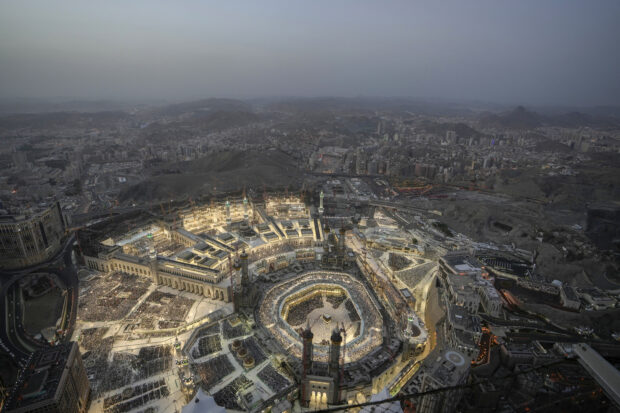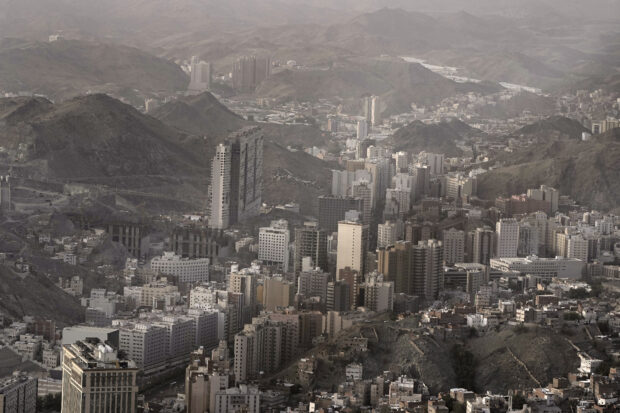What is it like living in Mecca? For residents, Islam’s holiest sites are simply home

A general view of the Grand Mosque is seen from the Clock Tower during the Hajj pilgrimage in the Muslim holy city of Mecca, Saudi Arabia, Thursday, June 22, 2023. Mecca is Islam’s holiest city and a focal point for the faith’s followers. (AP Photo/Amr Nabil)
MECCA, Saudi Arabia — For Zainab Abdu, the holiest sites in Islam were the backdrop for her weekends growing up.
Raised in Mecca, Abdu remembers roller-skating with friends near the Grand Mosque where the Kaaba is located. The desert plains and valleys that throng with pilgrims every year are where, in the off season, she and family and friends had picnics, rode horses and played soccer.
“The Haram (Grand Mosque) is my home,” said the 29-year-old pharmacist. “It’s my childhood. But people can’t imagine how normal life is for us. We do things that everyone else does.”
Mecca is Islam’s holiest city and a focal point for followers of the faith. It’s the birthplace of Prophet Muhammad, where Muslims believe he first received God’s revelations of the Quran. It’s the location of the Kaaba, the black, cube-shaped structure that Muslims around the world turn to five times a day when praying.
It’s also where around 2 million people live, work, and do ordinary activities like laundry, grocery shopping, homework, putting the trash out and paying the bills.
Article continues after this advertisement
A general view shows the Muslim holy city of Mecca, Saudi Arabia, Thursday, June 22, 2023. Mecca is Islam’s most sacred city and a focal point for the faith’s followers. But it’s also a place where around 2 million people live, work, and do everyday activities like laundry, grocery shopping, homework, putting the trash out, and paying the bills. Traffic, the population, and prices balloon during the peak Ramadan and Hajj seasons. (AP Photo/Amr Nabil)
Away from the pilgrim-dominated areas, the city’s modern neighborhoods spread out among boulevards with strip malls, gyms, schools and a university. The city has little of the glitz of Gulf cities like Dubai or Doha, or even Riyadh.
Article continues after this advertisementThe malls are modest, though bubble tea shops and well known chains like Sephora are moving in. One mall’s food court had a sign proclaiming that the U.S. fast-food chicken chain Popeyes was opening soon.
Daily life does make concessions to the city’s sacredness. Mecca has no cinemas, despite the government lifting a nationwide ban on movie theatres in 2018. For a cinema, residents go to the coastal city of Jeddah, about 70 kilometers (35 miles) away. Wedding halls are tucked away from sacred areas.
“It is a holy city and that needs to be respected,” Abdu said. “There is music at birthdays and other celebrations, but it won’t be loud.”
And once a year, the city’s population effectively doubles for up to a month as Hajj pilgrims from around the world flow in, as is happening this week. Security tightens in the streets to direct traffic as massive crowds move around the Grand Mosque and out to the holy sites in the nearby desert like Mina, Muzdalifa and Mount Arafat.
For Abdu, it means allowing extra time for traffic and avoiding certain routes because of road closures, even though she doesn’t live near the Grand Mosque. She also braces for hours of overtime because of the influx of pilgrims suffering from colds, flu symptoms, upset stomachs or muscular pains — all typical Hajj ailments. Born in Jeddah, Abdu has lived in Mecca since she was six.
Meccans used to have more personal interaction with the Hajj pilgrims. But the measures authorities have put in to control and organize the crowds have imposed a distance. Huge investment pouring in has transformed Mecca.
Back in the day, “people had their homes open” to pilgrims, said Fajr Abdullah Abdul-Halim, a 57-year-old who was born and raised in Mecca. “If someone was sick they used to treat them in their homes. Those were beautiful times.”
Abdul-Halim’s family home was close to the Grand Mosque, so they could watch pilgrims circling the Kaaba from their roof. Meccan families would just hang out around the Grand Mosque, since there were few other public spaces. Abdul-Halim recalled going there with her parents and siblings every afternoon for prayers and staying until the evening prayers.
Now a move to Jeddah after marriage and the passing of relatives in Mecca means she has fewer reasons to visit the city. The neighborhoods around the mosque have been transformed and are unrecognizable after the construction of monumental hotels, skyscrapers, highways and other infrastructure the past decade.
Both Abdul-Halim and Abdu said they used to do Hajj easily, with little to no advance planning. But the days when locals could just join in freely are over; now they must apply for a spot like everyone else and pay fees starting at $1,060 per person.
Still, there is a special pride in living in the city. Abdu recalled how in elementary school “we were told to set a good example for people because of Mecca’s status.”
“I’m always told I’m lucky, I can go (to the Grand Mosque) every day. People are so excited that I live here. Sometimes I feel I don’t go enough, but I’m so grateful. It’s a gift,” she said. “When it’s the Hajj, it’s like opening your home to guests. When those guests leave, you feel sad.”
A few days before Hajj’s official start Monday, Bangladeshi taxi driver Jahid Rojin sighed as his car crawled away from the Grand Mosque complex and headed to the city’s Aziziyah neighborhood.
“It’s always like this during the Hajj,” he said in Urdu, gesturing to streets teeming with sweaty pilgrims. Born in Dhaka, Rojin has lived in Mecca for 16 years, part of a significant South Asian community permanently residing there.
During Hajj season, the rent he pays his taxi’s owner jumps to around $1,600 a month from $1,000. He had to move out of his apartment because his landlord wanted to rent it out to pilgrims and make some extra money. But, he said, he’ll go back to his home once pilgrims leave, and traffic, prices and everything else will return to normal.
And he says there is an upside.
“The blessings and rizq (sustenance) you get from being in Mecca cannot be matched anywhere else in the world, anywhere else in Saudi Arabia,” he said, as he charged a desperate woman more than triple the regular journey fare to share his cab with two other passengers. “I’m very lucky to live here. I know that.”